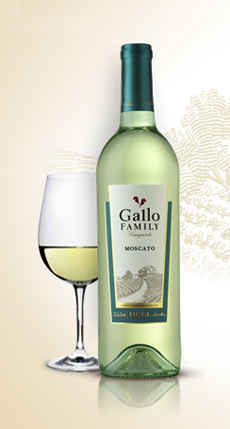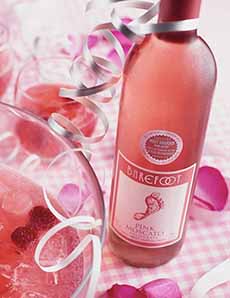What Is Moscato Wine, Red Moscato & The History Of Moscato
|
May 9th is National Moscato Day. Nearly two thousand years ago, the Roman author Pliny the Elder (23 C.E. – 79 C.E.) wrote in his Natural History: “The Muscat grape has been grown for a long time in Beaumes [in France] and its wine is remarkable.” Call it Muscat in French and English or Moscato in Italian: Today (2012) is the first National Moscato Day, celebrating the “remarkable” wine. The holiday was declared by Gallo Family Vineyards, producers of excellent and very affordable Moscato. By establishing National Moscato Day, the Gallo family hopes that you will raise a glass and get to know this delicious wine. The wine is already on a roll: Moscato sales in the U.S. continue to grow faster than any other wine varietal, increasing by 74% in 2011 alone. You can pick up a bottle of Gallo Moscato for about $5.00. How can you resist? Note that Gallo makes Moscato in red, white, and pink (as do other producers). At these prices, try them all! TIP: If you don’t like any particular wine that you’ve purchased, turn it into a cocktail by adding gin, tequila, or vodka. > Check out 15 Muscat and food pairings, below. > The history of Muscat, below. > All the white wine holidays. Moscato (mow-SKAH-toe) or Muscat (MOO-skaht) is a white wine grape. The wines, slightly sweet and low in alcohol, are often served with dessert. However, their ability to pair with other foods—and Americans’ penchant for sweet beverages like soft drinks and White Zinfandel—is bringing Moscato to the forefront in the U.S. According to Uncork.biz, the Muscat grape is the world’s oldest cultivated grape variety. It may have originated in the sultanate of Muscat and Oman† on the southeast Arabian Peninsula. The Muscat grape found its way to Rome and was brought by the Roman Legions to Gaul (encompassing present-day France). Over the centuries, it was planted in regions as disperse as the Crimea (Russia) and South Africa. Early Spanish and Italian immigrants brought it to America. In 1844, it arrived in Australia—the source of the grapes for the Gallo Family Muscato. The Moscato grape is widely grown in Italy, where it is vinified into still and sparkling wines. Asti Spumante and its semi-sparkling cousin, Moscato d’Asti, are made in the Piedmont region, the northwest corner of Italy. Moscato is light-bodied and low in alcohol—meaning that most people can have a second glass without overdoing it. The wine’s perfumed nose and lush palate burst with the seductive flavors of peach, honey, and citrus. The fresh acidity and delicate sweetness enable it to pair well with a broad variety of foods. > See food pairings below. While white wines (and occasionally pink rosé wines) made from the Muscat family of grapes have been made for thousands of years, red Moscato wine began to gain traction in the early 21st century. Red Moscato as a category emerged primarily as a market-driven product, when wine producers identified a growing consumer demand for sweeter red wine options for casual drinking. It’s typically made from red Muscat varieties like Black Muscat (called Muscat Hamburg in Europe) or by blending Muscat with red grape varieties to create a sweet, aromatic red wine. The grape was developed around the 1850s by British horticulturist William Leake, who crossed the white Muscat of Alexandria and the black grape Schiava Grossa (also known as Trollinger). The hybrid combines the aromatic qualities typical of the Muscat family with the color and some flavor characteristics of red grape varieties. It easily produces red Moscato wines. Before it was used to make wine, Black Muscat was a popular table grape, with a distinctive flavor. Home gardens appreciated its attractive appearance as well. Unlike other Muscat varieties that had established traditional styles as white wines, like Moscato d’Asti, red Muscat wines lacked a defined commercial category. Its production remained relatively limited and regionally specific for many decades. In some growing regions, there were challenges with yield and disease susceptibility, limiting its appeal to growers. Thus, red Muscat was stuck in a small niche: appreciated by some growers and winemakers but lacking the market demand and commercial infrastructure. That changed in the 21st century with the sweet red wine trend. The creation of Red Moscato as a commercial category essentially gave Black Muscat a more prominent role than it had enjoyed in its previous 150+ years of existence. Producers in various regions (particularly California and southern Europe) used Black Muscat to make limited-production sweet dessert wines. Like other Muscat varieties, Black Muscat has the distinctive floral, “grapey” Muscat aroma and flavor but with darker fruit characteristics. Experts note that the wines display notes of roses, exotic spices, and dark berries. Black Muscat is primarily used to produce sweet red dessert wines, fortified wines, and is one of the main varieties used in the production of commercial Red Moscato. 1983: In the U.S., California dessert wine maker Andrew Quady introduced Elysium Black Muscat wine. It was new and different for American wine drinkers (dessert wine was not yet popular). Elysium became something of a cult favorite. 2011-2012: Major brands like Sutter Home and Gallo (with their Barefoot label) began prominently marketing Red Moscato in the United States 2010-2015: The red Moscato category expanded significantly in North America as part of the broader sweet wine trend that included other products like sweet red blends. |
|
|
|
Treat yourself, and give bottles as gifts. Some suggestions in the different sub-categories of red Moscato: Some vintners make the wine less sweet (dryer) so that in addition to dessert, red Muscat can be served as a table wine, with everything from glazed ham, spicy foods, to recipes with fresh or dried cranberries (stuffing, chicken salad). *Gallo Moscato is so inexpensive because the grapes are grown in Australia, where land is plentiful and cheap. †Muscat and Oman were two separate entities until the 20th century. Muscat is now part of modern-day Oman. ‡The difference between red Muscat and fortified wine: The primary difference is in the production method. Red Muscat and other red dessert wines achieve sweetness through the natural grape sugar (from late harvest grapes) that remains unfermented. Fortified wine is fortified with alcohol (usually neutral grape spirits). If the spirits are added during fermentation the wine will be sweet; if added after, the wine will be dry. CHECK OUT WHAT’S HAPPENING ON OUR HOME PAGE, THENIBBLE.COM.
|
||








